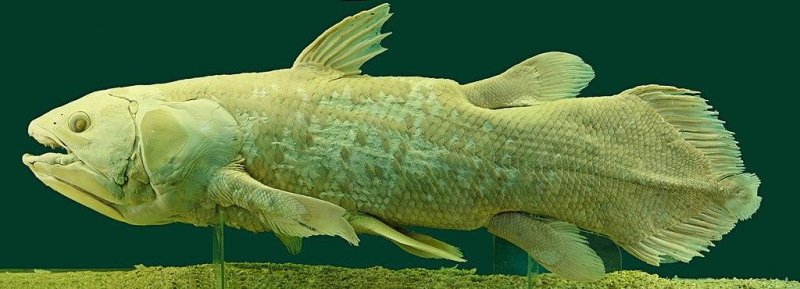The coelacanth was long thought to live for a few decades, but researchers have found they're wrong -- the fish can live for nearly 100 years, according to a new study. Photo by
Alberto Fernandez Fernandez/Wikimedia
June 17 (UPI) -- Until now, scientists estimated coelacanths, some of the deep sea's largest fish, lived only a couple of decades, suggesting the grow-fast-and-die-young strategy was alive and well several hundred feet beneath the ocean surface.
It turn out those early estimates were a bit off the mark.
New research -- published Thursday in the journal Current Biology -- suggests coelacanths can live for nearly a century. In fact, the mysterious fish don't even reach sexual maturity until the age of 55.
Given the elusive nature of coelacanths, the flawed lifespan estimates were understandable.
"Coelacanths are living in the deep-sea, between 100 and 800 meters deep, and staying in volcanic caves alone or in small groups, up to 7 individuals, during daylight," study co-author Bruno Ernande, researcher at the University of Montpellier in France, told UPI in an email.
Both divers and submarines have struggled to observe coelacanths for extended periods of time, and most recent studies have had to rely on small numbers of museum specimens.
There are only two known living coelacanth species, both of which represent the last remnants of an ancient lineage of lobe-finned fish and tetrapods.
In the 1970s, researchers examined growth rings on the scales of 12 coelacanths to estimate the fish's longevity. Analyzing the growth deposits, or circuli, like tree rings, scientists estimated the fish lived a maximum of 22 years.
"This result was very surprising considering the coelacanth's other known biological and ecological features -- low oxygen-extraction capacity, slow metabolism, ovoviviparity and low fecundity -- typical of fish with slow life histories and slow growth such as most deep water species," Ernande said.
Recent population-level studies of coelacanth fish have suggested longer lifespans, but until now, scientists hadn't directly analyzed coelacanth longevity.
For the new study, scientists used polarized-light microscopy and micro-computed tomography to examine the microstructures hidden in the scales of coelacanth specimens housed by various museums.
The high-definition imagery allowed for more detailed topographical analysis, revealing the presence of tiny calcified structures, or micro-circuli, hidden within the fish scales.
These imperceptible growth deposits were much more numerous, by a factor of 5, than the macro-circuli observed during previous investigations.
"We expected that coelacanth's age was underestimated, but we were taken aback when we realized that it was as much as by a factor of five," said Ernande. "A centenarian lifespan is quite something!"
Researchers were also surprised when they realized the gestational period for coelacanths is five years.
"Starting to reproduce after middle age is just unexpected for most animals," Ernande said.
The latest research suggests coelacanths have one of the slowest life histories in the animal kingdom, in or out of water.
While these characteristics make an already strange group of fish even more intriguing and peculiar, slow lifestyles also come with considerable risks.
"Long-lived species characterized by slow life history and relatively low fecundity are known to be extremely vulnerable to perturbations of a natural or anthropic nature due to their very low replacement or turnover rate," Ernande said.
"The African coelacanth is assessed as critically endangered in the Red List of Threatened Species of IUCN. Our results thus suggest that it may be even more threatened than expected due to its peculiar life history," Ernande said.
Researchers hope the latest findings will help conservationists and wildlife managers make more informed decisions about protections for coelacanths.
In followup studies, scientists said they plan to keep analyzing more coelacanth scales, in the hope of determining whether temperature influences growth and lifespan patterns among among the fish.















